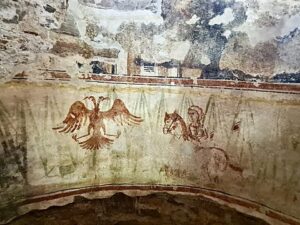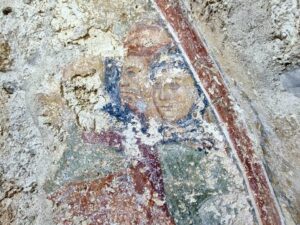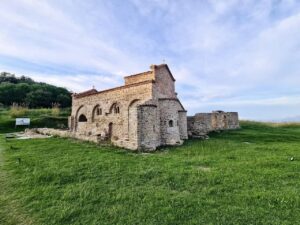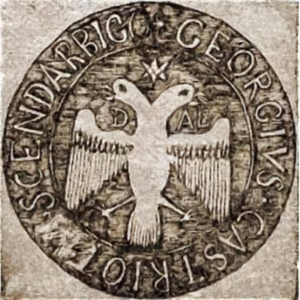The story of the double-headed eagle Albanian Flag
The latest discovery by the EU4Culture program brings us extraordinary views of the murals in the Church of Shen Ndou in Cape Rodon, Durres, Albania.
Unique, previously undiscovered murals in the Church of Rodoni, Durres, which were covered with plaster and lime, came to light during the restorations. Portraits and figures of saints have been cleaned and restored, giving this church extraordinary importance for Albanians and visitors.


In the middle of the murals is the double-headed eagle of Skanderbeg, which we still have on our flag. The eagle here is red, while next to it is a woman on a horse, considered dedicated to Mamica, the Sister of Skanderbeg, who lived here and even has her remains there. A few meters away is the Skanderbeg Castle, which he built with his hands. The castle is located at the very edge of the sea, which Skanderbeg built as a strategic point for exiting the sea.


Rodon was a historical place long before Skanderbeg. The Illyrians knew Redon as the God of the Sea (Poseidon in Hellenic). Due to its geographical position, this place was used as a shipyard to construct Illyrian ships, which then went to the Port of Ulqni (Liburnian ships).
This church is in the Roman-Gothic style of the 13th century, but some researchers place the construction of the Church of Saint Ndou and the Monastery of Saint Mary in the 14th century.

The legend of the “Eagle” on the red and black flag
The double-headed eagle, the symbol of our flag discovered in the Church of Rodon, is red in this mural, which is remarkable. Researchers say that it is the same color as Rosel’s map. After Skanderbeg’s death, the eagle became black in the subsequent flags as mourning for Skanderbeg, and the field of the red flag as the blood of Albanians shed for freedom over centuries. The same eagle is part of Skanderbeg’s seal on display in the Museum of Copenhagen, Denmark. This seal was displayed in Tirana on the 550th anniversary of Skanderbeg’s death in a grand exhibition.

There are many disputes about whether the double-headed eagle symbol represents Byzantium, which sees once from the East and once from the West. However, it is a fact that other countries did not use it in the variant that Albanians have continued to use since the time of Skënderbeu.
The red and black flag was later used by Ismail Qemali to be raised on Independence Day, November 12, 1912. This year, Albania celebrates the 112th anniversary of independence, also known as Flag Day. But the history of our flag, as this finding in the Church of Rodoni indicates, has its beginnings centuries and centuries ago.

Tags:
Other News to Read
The history of the Albanian Alphabet
The history of the Albanian Alphabet and survival of the Albanian Language in the most difficult periods of…
What Edith Durham wrote about Albanians
Descendants of the first Aryans of the Aryans and of the Illyrians, Thracians or Epirotes of classical times,…
Venetian Collection at National Library of Albania
Venetian Collection at National Library of Albania- open from 21 October to 17 November, 600 rare books and…
The story of the double-headed eagle Albanian Flag
The latest discovery by the EU4Culture program brings us extraordinary views of the murals in the Church of…